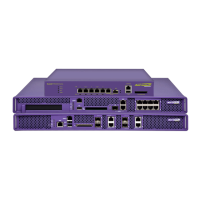Controller Information
Summit WM3000 Series Controller System Reference Guide48
Apart from the sections mentioned above, it also displays the following status:
1 Refer to the Alarms field for details of all the unacknowledged alarms generated during the past 48
hours. The alarms are classified as:
● Critical — Denoted by a red indicator. These alarms warrant immediate attention.
● Major — Denoted by a yellow indicator. These alarms warrant attention.
● Others — Denoted by a blue indicator.
The alarms field also displays details (in a tabular format) of the 5 most recent unacknowledged
critical/major alarms raised during the past 48 hours. The table displays the following details:
2 Refer to the Ports field for link, speed and duplex status of each physical port on the controller’s
front panel. It displays the following details in a tabular format:
3 The Environment section displays the CPU temperature. It displays the valid threshold range set by
the user.
4 The CPU/Memory section displays the free memory available with the RAM.
Redundancy State
Displays the Redundancy State of the controller. The status can be either
Enabled or Disabled.
Enabled
- Defined a green state.
Disabled
- Defined by a yellow state.
Firmware
Displays the Firmware version of the current software running on the
wireless controller.
Management IP
Displays the Management IP address of the controller.
Access Points
Displays the total number of Access Points adopted by the controller.
Mobile Units
Displays the total number of MUs associated with the controller.
Up Time
Displays the actual controller uptime. The
Uptime
is the current
operational time of the device defined within the System Name field.
Uptime is the cumulative time since the controller was last rebooted or
lost power.
Severity
Displays the severity of the alarm. It can be either Critical or Major.
Last Occurrence
Displays the time when the alarm was reported.
Message
Displays the message associated with the alarm.
# Occurrences
Displays the number of times during the past 48 hours such an alarm was
generated.
Name
Displays the name of the port (ge1-8, me1 or up1)
Status
Displays the status of the port, either— Up or Down
Speed
Displays the speed at which the port transmits or receives data.
Duplex
Displays the status of the port, either— Full Duplex or Unknown.

